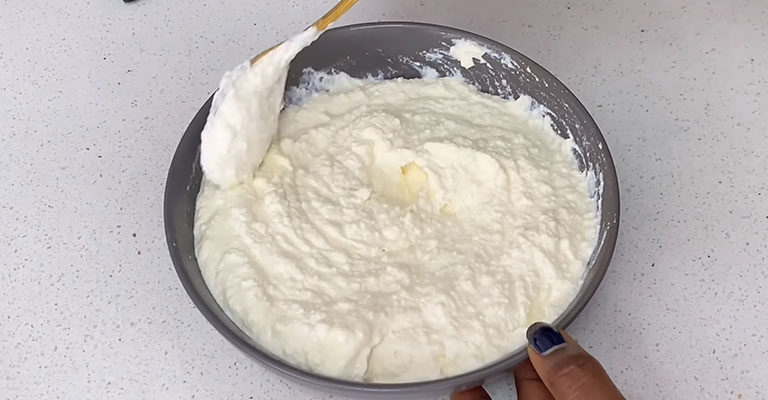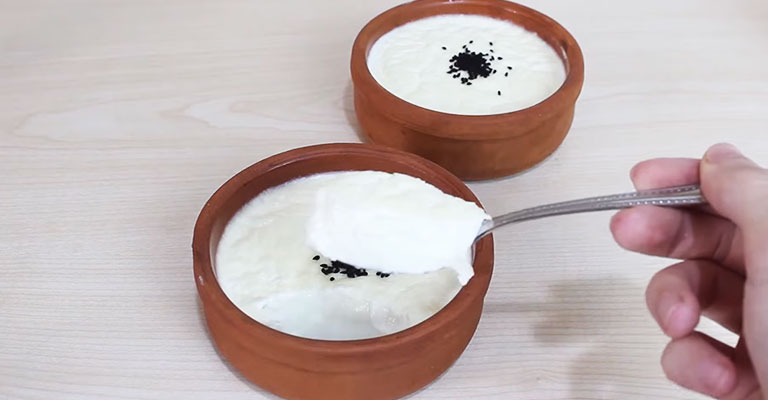Why Is My Yogurt Grainy?-Unraveling the Mystery

Homemade yogurt, a nutritious and versatile delight, often graces our tables with its creamy goodness.
However, at times, the texture may leave much to be desired, presenting as grainy rather than smooth. This unexpected phenomenon can be perplexing for any avid yogurt maker.
Understanding why yogurt turns grainy is pivotal in honing this culinary craft. A combination of factors, from temperature fluctuations to starter culture choices, can influence this outcome.
In this exploration, we’ll dissect the potential culprits behind grainy yogurt and offer insightful tips to prevent and rectify this common hiccup. So, let’s embark on a journey to uncover the secrets of achieving consistently silky-smooth homemade yogurt.
Why Is My Yogurt Grainy?
Grainy yogurt can be a frustrating experience, especially when you’re expecting a smooth and creamy texture. There are several reasons why your yogurt may turn out grainy.
Here are some of the most common culprits:
Incomplete Mixing
Properly incorporating the starter culture or yogurt culture into the milk is crucial for achieving a smooth texture.
Ensure that the culture is evenly dispersed throughout the milk, as any pockets of concentrated culture can result in uneven fermentation, leading to a grainy consistency.
Incorrect Temperature
Maintaining the right fermentation temperature is essential for successful yogurt-making. If the temperature is too low, the cultures may not activate efficiently, leading to incomplete fermentation and a grainy texture.
Conversely, excessively high temperatures can cause the milk proteins to denature, resulting in a coarse texture.
Low Milk Fat Content
Yogurt made from low-fat or skim milk tends to produce grainy results.
The fat content in whole milk contributes significantly to creaminess. Reducing the fat content can lead to a less smooth texture in the final product.
Overheating During Pasteurization
Care should be taken during the pasteurization process.
When the milk is heated too rapidly or too high a temperature, it can cause the proteins to denature excessively, which may result in graininess in the final product.
Over-Fermentation
Allowing the yogurt to ferment for an extended period can lead to a grainy texture. The cultures continue to work on the milk, potentially causing the texture to become coarse and granular.
Old or Expired Culture
Using outdated or expired yogurt starter cultures can lead to grainy yogurt. The cultures may not be as active or effective, which can result in incomplete fermentation and an undesirable texture.
Contaminated Utensils or Equipment
Ensuring that all utensils and containers are thoroughly cleaned and sanitized is crucial.
Any residual bacteria or foreign particles can negatively impact the yogurt’s texture, resulting in an undesirable graininess.
Milk Quality
The quality of the milk used can significantly influence the final texture of the yogurt.
Milk that has undergone certain processes or has been exposed to temperature fluctuations prior to use may lead to an undesirable grainy texture.
Agitation During Fermentation
It’s important to avoid unnecessary agitation or stirring of the yogurt while it’s fermenting. Excessive movement can disrupt the fermentation process, potentially leading to a grainy texture.
Inconsistent Milk Composition
Different batches or brands of milk can have variations in protein and fat content.
These differences can affect the final texture of the yogurt, so it’s important to be mindful of the milk’s composition when making yogurt.
The Nature of Yogurt

Yogurt is a dairy product that undergoes a fermentation process, transforming milk into a creamy, tangy, and nutritionally rich food.
This transformation is primarily driven by the action of beneficial bacteria, known as probiotics, which convert lactose (the natural sugar in milk) into lactic acid.
Here are some key aspects that define the nature of yogurt:
Probiotic Powerhouse
Yogurt is renowned for its probiotic content. These live microorganisms, primarily strains of Lactobacillus bulgaricus and Streptococcus thermophilus, are beneficial bacteria that offer a range of health benefits.
They support digestive health, boost the immune system, and may even contribute to a balanced gut microbiome.
Fermentation Process
The transformation of milk into yogurt is achieved through a controlled fermentation process. This involves adding a small amount of existing yogurt to warm milk.
The cultures then multiply and convert lactose into lactic acid, which gives yogurt its characteristic tangy flavor and helps preserve it.
Nutrient-Rich
Yogurt is a nutrient-dense food. It’s an excellent source of protein, calcium, B vitamins (such as B12), and minerals like phosphorus and potassium.
Additionally, yogurt is often fortified with vitamin D, which is crucial for bone health.
Diverse Varieties
The world of yogurt is incredibly diverse. Beyond the standard plain or flavored varieties, there are numerous regional and specialty yogurts.
These include Greek yogurt (strained to remove excess whey for a thicker consistency), Icelandic skyr, and various ethnic yogurts like Indian dahi and Middle Eastern labneh.
Lactose Tolerance
Due to the fermentation process, yogurt is generally easier to digest for individuals who are lactose intolerant.
The beneficial bacteria in yogurt help break down lactose, making it more tolerable for many people.
Culinary Versatility
Yogurt’s versatility extends beyond being a standalone snack or breakfast item. It can be used in a wide array of culinary applications.
It’s used in sauces, dressings, marinades, smoothies, baked goods, and even in soups and stews, imparting a creamy texture and a tangy flavor.
Health Benefits
Beyond its nutritional content, yogurt offers a range of health benefits.
Regular consumption is associated with improved digestion, enhanced immune function, and reduced risk of certain chronic diseases. It’s also linked to better weight management and heart health.
Regulatory Standards
Many countries have specific regulations governing the production and labeling of yogurt.
These standards often specify factors like minimum bacterial counts, allowable ingredients, and processing methods.
Homemade Yogurt
Yogurt-making is not limited to industrial production. Many people enjoy making their own yogurt at home, which allows for customization of flavors, thickness, and probiotic content.
This process typically involves heating milk, inoculating it with a yogurt starter, and allowing it to ferment at a controlled temperature.
Troubleshooting Grainy Yogurt

Grainy yogurt can be disappointing, but with some troubleshooting, you can often identify the issue and make adjustments to achieve a smoother texture.
Here are common problems and their solutions when dealing with grainy yogurt:
Incomplete Mixing
- Problem: Uneven distribution of the starter culture or yogurt culture in the milk.
- Solution: Stir the culture thoroughly into the warm milk to ensure even dispersion.
Incorrect Temperature
- Problem: The fermentation temperature is too high or too low.
- Solution: Use a thermometer to maintain the correct temperature (around 110-115°F or 43-46°C) during fermentation.
Low Milk Fat Content
- Problem: Using low-fat or skim milk can result in a grainy texture.
- Solution: Try using whole milk for creamier yogurt, or add milk powder to increase the fat content.
Overheating During Pasteurization
- Problem: Overheating the milk can denature proteins, causing graininess.
- Solution: Heat the milk gently, stirring occasionally, until it reaches the pasteurization temperature (around 180°F or 82°C), and then cool it to the fermentation temperature.
Over-Fermentation
- Problem: Allowing the yogurt to ferment for too long can lead to graininess.
- Solution: Follow the recommended fermentation time for your yogurt recipe and avoid over-fermenting.
Old or Expired Culture
- Problem: Using outdated or expired yogurt starter culture can lead to grainy yogurt.
- Solution: Use a fresh and active culture. Store-bought yogurt is a good source of fresh starters.
Contaminated Utensils or Equipment
- Problem: Unsanitary equipment or utensils introduce unwanted bacteria.
- Solution: Clean and sanitize all utensils and containers thoroughly before use.
Milk Quality
- Problem: The quality of the milk used can affect the texture of the yogurt.
- Solution: Use fresh, high-quality milk with no additives or preservatives.
Agitation During Fermentation
- Problem: Agitating or stirring the yogurt during fermentation can disrupt the process.
- Solution: Leave the yogurt undisturbed while it’s fermenting.
Inconsistent Milk Composition
- Problem: Variations in milk protein and fat content can affect the texture.
- Solution: Be consistent with the type and brand of milk you use, or adjust the recipe to account for any differences in milk composition.
Straining Yogurt
- Problem: Straining yogurt to make Greek yogurt or other variations can result in graininess.
- Solution: When you want a thicker yogurt, use milk with a higher fat content, or strain the yogurt after fermentation.
How Grainy Yogurt Can Be Salvaged?
Grainy yogurt can be salvaged with a few simple steps. If your yogurt has turned grainy, it’s not necessarily a lost cause.
Here’s how you can smooth out grainy yogurt:
Blend It
One of the most effective methods to salvage grainy yogurt is to use a blender. Pour the grainy yogurt into a blender, and blend it on low to medium speed until it becomes smooth. This can help break down the clumps and create a creamier texture.
Straining
When your yogurt is grainy due to excess whey separation, you can strain it to improve the texture. Place a fine-mesh strainer or a piece of cheesecloth over a bowl, and pour the grainy yogurt into the strainer. Allow it to strain for a few hours or overnight in the refrigerator.
Add a Stabilizer
To prevent future graininess, you can add a stabilizer to your yogurt during the fermentation process. Gelatin, agar-agar, or cornstarch are common stabilizers that can help maintain a smooth texture.
Follow a trusted recipe for precise measurements and instructions on when to add the stabilizer.
Use a Different Starter
When graininess is a recurring issue, consider changing the starter culture you use for yogurt fermentation. A fresh, high-quality starter culture with the right blend of probiotics can result in smoother yogurt.
Proper Fermentation
Ensure that you are not over-incubating your yogurt. Over-fermentation can lead to grainy texture. Follow the recommended incubation time for the type of yogurt you are making.
Homogenize Milk
When you’re making yogurt from scratch using milk, make sure to homogenize the milk properly before heating and adding the starter culture. This can help prevent the separation that leads to grainy yogurt.
Temperature Control
Maintaining a consistent incubation temperature is crucial. Fluctuations in temperature during the fermentation process can lead to texture issues.
Use a yogurt maker or another method to control and monitor the temperature.
Tips for Preventing Grainy Yogurt in Future
Preventing grainy yogurt in the future involves paying attention to various aspects of the yogurt-making process.
Here are some tips to ensure a smooth and creamy texture:
Consistent Temperature
Maintain a steady incubation temperature. Fluctuations can lead to texture issues. Use a yogurt maker or a warm environment to control the temperature.
Use Fresh, Active Starter
Ensure your starter culture is fresh and active. Using old or weakened cultures can result in grainy yogurt. Purchase a new starter or regularly refresh your own from a previous batch.
Follow Recommended Incubation Time
Stick to the recommended incubation time for the type of yogurt you’re making. Over-incubating can lead to graininess. Use a timer to keep track accurately.
Avoid Agitation
Resist the urge to stir or move the yogurt during incubation. Agitating the mixture can introduce air and disrupt the fermentation process, leading to a grainy texture.
Homogenize Milk Properly
When you’re using fresh milk, ensure it’s properly homogenized. This helps prevent separation and results in a smoother texture.
Use a Stabilizer
Consider adding a stabilizer like gelatin, agar-agar, or cornstarch to the milk before heating. This can help maintain a smooth texture by preventing excessive whey separation.
Strain if Necessary
When you prefer thicker yogurt or notice excess whey separation, consider straining the yogurt after incubation. This can remove excess liquid, resulting in a creamier texture.
Avoid Ultra-Pasteurized Milk
Ultra-pasteurized milk can sometimes lead to grainy yogurt due to the high heat treatment. Opt for regular pasteurized or raw milk for better results.
Use Quality Ingredients
Use high-quality milk and other ingredients. Lower-quality or adulterated milk can lead to texture issues in the finished yogurt.
Clean Equipment Thoroughly
Ensure all utensils, containers, and equipment are clean and sanitized before use. Any residue or contaminants can affect the fermentation process and texture of the yogurt.
Experiment with Different Starters
When graininess persists, try using a different type or brand of starter culture.
Different strains of bacteria can yield varying textures, so finding the right one for your taste may take some experimentation.
Adjust Milk-to-Starter Ratio
Experiment with the ratio of milk to starter culture. Using too much starter can sometimes lead to a grainy texture. Follow recommended ratios and adjust as needed.
FAQs
Why is my yogurt grainy?
Grainy yogurt is often the result of temperature fluctuations during fermentation or over-agitation of the mixture.
Can using a different starter culture affect the texture of my yogurt?
Yes, different strains of bacteria in starter cultures can yield varying textures.
How can I prevent grainy yogurt in the future?
To prevent grainy yogurt, maintain a consistent incubation temperature, use a fresh and active starter culture, and avoid stirring or agitating the mixture during fermentation.
Can I salvage grainy yogurt?
Yes, grainy yogurt can often be salvaged. Techniques like blending or straining can help smooth out the texture.
Can the type of milk I use affect the texture of my yogurt?
Yes, the type of milk you use can impact the texture of your yogurt.
To Recap
In the pursuit of perfecting homemade yogurt, encountering graininess can be frustrating. Understanding the underlying causes is crucial.
Factors like temperature fluctuations, improper starter cultures, and over-agitation can all contribute to this texture issue. However, armed with knowledge and a few techniques, grainy yogurt can be prevented and salvaged.
Maintaining a consistent incubation temperature, using fresh and active starters, and adhering to recommended incubation times are fundamental practices.
Straining, blending, or incorporating stabilizers can also aid in achieving a smoother texture. Experimentation with starters and milk types allows for personalized yogurt-making.
With these considerations, grainy yogurt need not be a stumbling block in your culinary endeavors.
